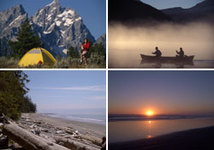The unofficial BC Travel & Tourism Guide
Kokanee Creek

Activities in the park are many. There are 9.5 km of easy hiking and walking trails in the immediate vicinity of the Visitor Centre, creek and beach. Canyon Trail follows the east side of Kokanee Creek and offers splendid views, especially during the spring and summer melt when water is forced through the narrow channel. It links up with other trails that pass through the splendid forests of cedar, hemlock, birch and pine. It is also an ideal place to plan for more vigorous hiking in the West Kootenays, including in nearby Kokanee Glacier Provincial Park which offer over 100 km of alpine wilderness. Besides hiking, the area is ideal for all kinds of boating, from kayaking to water skiing to windsurfing. The lake has good fishing for kokanee, dolly varden and rainbow trout. While the lake is always refreshing, its temperature is moderated by the shallow water around the delta and the beach can get very warm during the long days of summer. Other activities include wildlife viewing, ice fishing, cross-country skiing, snowshoeing and skating. Keep in mind that most of the facilities are closed in the off-season, although road access is possible even in winter.
Wildlife in the area includes an abundant bird population that thrives around the delta. The park is known for one of the highest densities of ospreys in North America. Deer, coyote and black bear are all present. South facing slopes above Highway 3A provide winter habitat for mule and whitetail deer while the shallow bays of the
arm are used as feeding and nesting areas by waterfowl and shorebirds.
Camping is plentiful in park, with two vehicle-accessed campsites, Sandspit and Redfish, providing 168 vehicle/tent campsites. The majority of facilities are located at Sandspit, which is able to accommodate larger vehicles. Redfish is a more wooded and smaller facility. There are group camping facilities, day-use areas, nature centre, boat ramps, a special dog friendly beach near the boat launch, adventure playground, toilets, change house, pay-phones, horseshoe pit, fountains with taps, pit toilets and barbeque stands. The park has 240 spaces for day-use parking. Campfires are permitted but you are encouraged to preserve wood by using camp stoves. For reservations go to: www.discovercamping.ca
Location and access:
The park is accessed from Hwy 3A, 19 km east of Nelson via the Kootenay Lake ferry.
Contact Kokanee Creek
Contact Name: West Kootenay Park Management Inc.Phone: 250-825-4212
Email: kokaneecreek@westkootenayparks.com
Website: www.env.gov.bc.ca/bcparks/explore/parkpgs/kokanee_crk/
Just click on the following links for more information about nearby communities such as
